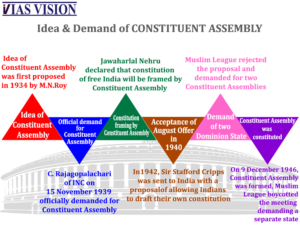BACKGROUND COMPOSITION CONSTITUENT ASSEMBLY
CONSTITUENT ASSEMBLY of india & drafting committee
Idea and demand of constituent assembly
BACKGROUND COMPOSITION CONSTITUENT ASSEMBLY
An idea for a Constituent Assembly was proposed in 1934 by M.N.Roy, which became an official demand of the Indian National Congress in 1935,The Indian National Congress held its session at Lucknow on April 1936 presided by Pt. Jawahar Lal Nehru.

The official demand for Constituent Assembly was raised by C. Rajagopalachari on 15 November 1939 based on adult franchise, and was accepted by the British in August 1940.
August offer in 1940, included the idea of allowing Indians to draft their own constitution.
Under the roadmap proposed by Cabinet Mission Plan of 1946, indirect elections were held for the first time for the Constituent Assembly. Under the prepared roadmap Provincial assemblies nominated members to the constituent assembly of un-divided India provincial by a single, transferable-vote system of proportional representation.
SCHEME OF REPRESENTATION IN CONSTITUENT ASSEMBLY
The total membership of the Constituent Assembly OF un-divided india was 389 of which 292 were representatives of the provinces elected through an indirect election, similar to that of present day rajya sabha, 93 represented the princely states as decided by the chamber of princes, representing one-third of geography of india and respecting population distribution and four were from the chief commissioner provinces of Delhi, Ajmer-Merwara, Coorg and British Baluchistan.
CONSTITUENT ASSEMBLY DIVIDED
On 9 December 1946 the Assembly began its first session, with only 211 mostly congress members attending. Muslim League boycotted demanding pakistan and princely states were undecided about joining india or remaining independent – which they thought was possible & just.
Muslims who constituted around 25% of indias population, led by Jinnah believed feared majority repression as against, security of separate electorate provided in British india. Muslim League wanted Pakistan, basis of which could be the communally affected provincial elections of 1946.
Mountbatten arrived in india in March,1947 & convinced Sardar Patel led congress, which opposed partition to it”s inevitability.
CONSTITUENT ASSEMBLY PARTITIONED
As a result of the partition under the Mountbatten Plan of 3 June, 1947, a separate Constituent Assembly was set up for Pakistan and representatives of some Provinces ceased to be members of the Assembly. In June 1947 delegations from Sindh, East Bengal, Baluchistan, West Punjab and the North West Frontier Province withdrew to form the Constituent Assembly of Pakistan, meeting in Karachi. Members of the Constituent Assembly who had not withdrawn to Karachi became India's Parliament. Twenty-eight members of the Muslim League joined the Indian Assembly. Reconstituted constituent Assembly had a membership of 299.
Landmarks in constitution of india
The Constituent Assembly took almost three years (two years, eleven months and seventeen days to be precise) to complete its historic task of drafting the Constitution for Independent India. During this period, it held eleven sessions covering a total of 165 days. Of these, 114 days were spent on the consideration of the Draft Constitution.
The Constitution of India was adopted on 26 November, 1949 & started functioning partially from that day.
Full constitution, became operational from 26th of January 1950 due to its historic significance.
COMPOSITION OF THE MEMBERSHIP OF THE CONSTITUENT ASSEMBLY OF INDIA AS ON 31 DECEMBER, 1947
BACKGROUND COMPOSITION CONSTITUENT ASSEMBLY:
PROVINCES-229
| S.No
|
State | No. of Members |
| 1. | Madras | 49 |
| 2. | Bombay | 21 |
| 3. | West Bengal | 19 |
| 4. | United Provinces | 55 |
| 5. | East Punjab | 12 |
| 6. | Bihar | 36 |
| 7. | C.P. and Berar | 17 |
| 8. | Assam | 8 |
| 9. | Orissa | 9 |
| 10. | Delhi | 1 |
| 11. | Ajmer-Merwara | 1 |
| 12. | Coorg | 1 |
INDIAN STATES-70
| 1. | Alwar | 1 |
| 2. | Baroda | 3 |
| 3. | Bhopal | 1 |
| 4. | Bikaner | 1 |
| 5. | Cochin | 1 |
| 6. | Gwalior | 4 |
| 7. | Indore | 1 |
| 8. | Jaipur | 3 |
| 9. | Jodhpur | 2 |
| 10. | Kolhapur | 1 |
| 11. | Kotah | 1 |
| 12. | Mayurbhanj | 1 |
| 13. | Mysore | 7 |
| 14. | Patiala | 2 |
| 15. | Rewa | 2 |
| 16. | Travancore | 6 |
| 17. | Udaipur | 2 |
| 18. | Sikkim and Cooch Behar Group | 1 |
| 19. | Tripura, Manipur and Khasi States Group | 1 |
| 20. | U.P. States Group | 1 |
| 21. | Eastern Rajputana States Group | 3 |
| 22. | Central India States Group (including Bundelkhand and Malwa) | 3 |
| 23. | Western India States Group | 4 |
| 24. | Gujarat States Group | 2 |
| 25. | Deccan and Madras States Group | 2 |
| 26. | Punjab States Group I | 3 |
| 27. | Eastern States Group I | 4 |
| 28. | Eastern States Group II | 3 |
| 29 | Residuary States Group | 4 |
|
Total |
299 |
